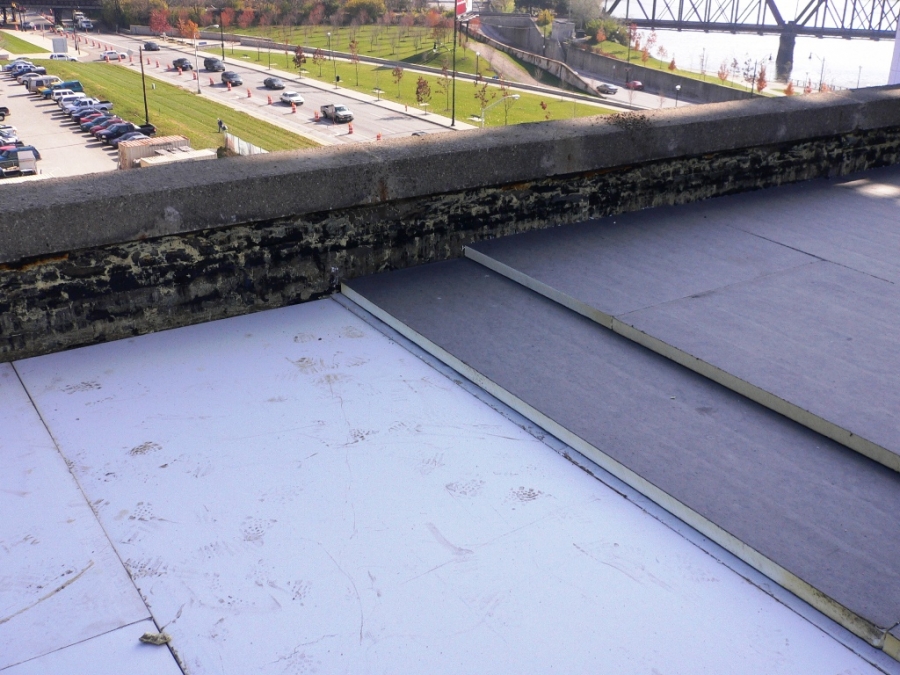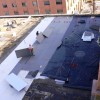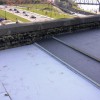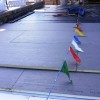Roof and Deck Insulation
The purpose of roof and deck insulation is to provide resistance to thermal energy. When insulation can inhibit the flow of thermal energy, the result will be a greater capacity to conserve heating and cooling energy. Heat flows from hot to cold due to conduction, convection and radiation. Heat is measured using the British Thermal Unit (BTU) where a BTU is the energy required to raise the temperature of one pound of water by one degree Fahrenheit. Therefore, a material with a higher R-value will provide greater thermal resistance. The roof of a building can be the structure's largest surface area, and consequently the area in which heat has the greatest opportunity to escape. With the correct type of insulation specified as part of the roof system, it will meet energy performance requirements and codes and provide many years of fundamental performance.

Topic Summary
There are many forms of thermal insulation used for roofs that are either applied on top of the roof deck or within the attic space. This summary will focus on two types of insulation, asphaltic perlite concrete deck and roof board insulation, both of which are intended to be installed as roof and deck insulation. With either type of insulation, it is recommended that a minimum of two layers be installed with the joints of each layer being staggered and offset. One reason for this is that it will reduce the thermal loss that would otherwise occur at the gaps between boards if just one layer were installed. Many state and local building codes have adopted the International Building Code (IBC). This code references the International Energy Conservation Code (IECC) which makes recommendations for a minimum thermal resistance (R-Value) to meet the energy standards based on different U.S. climate zones. Therefore, as part of the selection process, it is important to know the R-Value of the various insulating materials.
Asphaltic perlite concrete is manufactured from expanded volcanic minerals and combined with organic fibers and binders. The tiny air pockets that are generated during the intense heat of the manufacturing process are what give this board its insulating value. The surface is typically treated with an asphaltic product to minimize any absorption of additional layers of adhesive. The advantages of using perlite concrete include its insulating values and fire resistance, as well as the fact that it is lightweight and dimensionally stable. The average R-Value of perlite concrete board is 2.78 per inch. ASTM C 728 “Standard Specification for Perlite Thermal Insulation Board” covers the material standardization of perlite. Perlite concrete boards typically come in ¾ and 1 inch thickness. Because perlite insulation boards can absorb moisture, it is recommended that the installed boards be covered with the roof membrane right away.
Rigid board insulation consists of three basic forms: cellulose, fiberglass and polymers. Each of these materials is manufactured into a rigid board, sometimes with protective wraps.
Types of most commonly used rigid insulation for roofs, and their typical R-Values (low-slope membrane systems):
|
Insulation |
R-Value per inch |
Compressive Strength (PSI) |
|
Asphaltic Perlite Concrete |
2.86 |
35 |
|
Cellular-Glass |
2.86 |
90 + |
|
Polyisocyanurate Board |
5.60 |
Type II, Grade 1: 16 Type II, Grade 2: 20 Type II, Grade 3: 25 |
|
Expanded Polystyrene Board (EPS or Beadboard) |
3.85 3.92 4.17 4.35 |
Type I: 10 Type VIII: 13 Type II: 15 Type IX: 25 |
|
Extruded Polystyrene Board (XPS) |
5.00 |
Type X: 15 Type IV: 25 Type VI: 40 |
|
Wood-Fiberboard |
2.78 |
Type II, Grade 2: 24 @ 1/2 inch thickness |
|
Gypsum Board |
0.56 / (1/2 inch) |
350 + |
Cellular glass insulation is made up of heat fused glass combined with a foaming agent. The recognized standard is ASTM C 552 “Standard Specification for Cellular Glass Thermal Insulation”. Type IV is designed for roofing applications. The advantage of using cellular glass insulation is its ability to be compatible with many other roofing system materials. It is also moisture resistant, fire resistant and dimensionally stable. If the kraft paper facing is allowed to get wet, the adhesive will begin to degrade. It is recommended that cellular glass insulation be adhered to the structural substrate; the use of mechanical fasteners can cause spalling and crumbling.
Polyisocyanurate board is manufactured through a controlled chemical reaction. Once this mixture of chemicals reacts with the catalyst, the resulting cellular foam is solid, lightweight and thermally resistant. The closed cell polyisocyanurate rigid foam will get cut into specified sizes and a material will be applied to each face. These face layers can include aluminum foils, glass-fiber reinforced mats, and coated and uncoated polymer-bonded glass-fiber mats. The recognized standard is ASTM C 1289 “Standard Specifications for Faced Rigid Board Cellular Polyisocyanurate Thermal Insulation”. Of the many types available, Type I, Class 1, and Type II, Class 1 is intended for roof installations. The advantage of using polyisocyanurate insulation is its ability to be compatible with bitumen, adhesives, and other roofing materials. It is also moisture and fire resistant and dimensionally stable. Polyisocyanurate boards can be mechanically attached to the roof deck.
Expanded polystyrene board is also referred to as EPS or bead board. EPS is a polymer based material; it is mixed with a foaming agent and poured into closed containers, and when exposed to heat, it expands into beads. In the final process the beads are injected into molds of various thicknesses and sizes, where pressure and heat are applied once more. Because it is also a closed-cell product, it is resistant to moisture and the effects of heat transfer. The recognized standard is ASTM C 578-95 “Standard Specifications for Rigid, Cellular Polystyrene Thermal Insulation”. Ultraviolet degradation and moisture absorption are possible under certain conditions. The minimum density of EPS recommended for use as roofing insulation is 1.25 pounds per cubic foot.
Extruded polystyrene board is referred to as XPS. Like EPS, XPS is a polymer based material; the difference is that the blend of chemicals is heated and put through an extrusion process under pressure, which gives it a smooth finish, and it is allowed to expand up to 30 times its original size. During the expansion process, closed cells are formed within the polystyrene material. The recognized standard is the same as EPS. XPS is more resistant to moisture which makes it ideal for roof systems.
Wood fiberboard begins as a mixture of cellulose fibers of wood, cane, or vegetable fibers mixed with binders and asphalt. The mixture is heated in dryers and forms rigid boards. The recognized standard is ASTM C 208 “Standard Specifications for Cellulose Fiber Insulation Board”. Of the six types of wood fiberboard insulation available, Type II is specifically for roofing applications. Wood fiberboard insulation is combustible, therefore use of torch applications as a method of attaching additional layers is not recommended.
Gypsum board core can be a mixture of water, gypsum, Portland cement, glass fibers, and other additives which combine to produce a moisture resistant, noncombustible, nonstructural board. This core material can be faced with paper or glass fiber mat. Although gypsum board has minimal R-Value, it does provide a substrate for roof assemblies, cover boards, and barriers to provide fire resistance. Because gypsum boards are noncombustible, they can be exposed to hot bitumen and the flame of a torch.

Buildipedia Staff
The Buildipedia research and writing staff consists of dozens of experienced professionals from many sectors of the industry, including architects, designers, contractors, and engineers.
Website: buildipedia.com/




